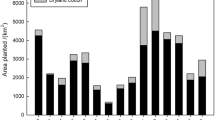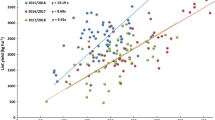Abstract
Improving the efficiency of nitrogen (N) fertiliser use is one means of reducing greenhouse gas emissions, particularly in irrigated crops such as cotton (Gossypium hirsutum L.). Internal crop N use efficiency (iNUE) was measured within two N fertiliser rate experiments that covered a wide range of N fertility over six cropping seasons. Crop iNUE was determined by dividing lint yield by crop N uptake. No nutrients other than N limited cotton growth or yield and the crops were irrigated to avoid drought stress. The optimal N fertiliser rates were determined from fitted quadratic functions that related lint yields with N fertiliser rates for each cropping system in each year. When the optimal N fertiliser rate was applied, crop iNUE averaged 12.5 ± 0.2 kg lint/kg crop N uptake. The crop iNUE was then used to determine the degree to which N fertiliser was under or over-applied, with respect to the economic optimum N fertiliser rate. Low iNUE values were associated with excessive N fertiliser application. Crop iNUE was determined in 82 commercial cotton crops in six valleys over the final 4 years of this study. The crop iNUE value was high in 8 fields (10%), optimal in 9 fields (11%) and low in 65 fields (79%). Crop N uptake averaged 247 kg N/ha, yield 2,273 kg lint/ha and crop iNUE 10.1 kg lint/kg crop N uptake for these sites. Averaged over all sites and years, about 49 kg N/ha too much N fertiliser was applied. Apparent N fertiliser recovery by cotton in the N rate experiments ranged from <20% in N-fertile treatments where legume crops had been grown, to more than 60% following winter cereal crops. Information on crop iNUE will enable cotton producers to assess their N fertiliser management and adjust N fertiliser rates for future crops. This study has demonstrated that there is scope to substantially reduce N fertiliser inputs to Australian cotton fields without reducing yields.







Similar content being viewed by others
References
Bassett DM, Anderson WD, Werkhoven CHE (1970) Dry matter production and nutrient uptake in irrigated cotton (Gossypium hirsutum). Agron J 62:299–303
Bauer PJ, Camberto JJ, Roach SH (1993) Cotton yield and fiber quality response to green manures and nitrogen. Agron J 85:1019–1023
Bronson K (2008) Nitrogen use efficiency of cotton varies with irrigation system. Better Crops with Plant Food 92:20–22
Bronson KF, Onken AB, Keeling JW, Booker JD, Torbet HA (2001) Nitrogen response in cotton as affected by tillage system and irrigation level. Soil Sci Soc Am J 65:1153–1163
Constable GA, Rochester IJ (1988) Nitrogen application to cotton on clay soil: timing and soil testing. Agron J 80:498–502
Janat M (2005) Assessment of nitrogen content, uptake, partitioning, and recovery by cotton crop grown under surface irrigation and drip fertigation by using isotopic technique. Comm Soil Sci Plant Anal 35:2515–2535. doi:10.1081/LCSS-200030355
Janat M (2008) Response of cotton to irrigation methods and nitrogen fertilization: yield components, water-use efficiency, nitrogen uptake, and recovery. Comm Soil Sci Plant Anal 39:2282–2302. doi:10.1080/00103620802292293
Millar N, Robertson G, Grace P, Gehl R, Hoben J (2010) Nitrogen fertilizer management for nitrous oxide (N2O) mitigation in intensive corn (Maize) production: an emissions reduction protocol for US Midwest agriculture. Mitig Adapt Strateg Glob Change. doi:10.1007/s11027-010-9212-7
Mullins GL, Burmester CH (1990) Dry matter, nitrogen, phosphorus and potassium accumulation by four cotton varieties. Agron J 82:729–736
Naklang K, Harnpichitvitaya D, Amarante ST, Wade LJ, Haefele SM (2006) Internal efficiency, nutrient uptake, and the relation to field water resources in rainfed lowland rice of northeast Thailand. Plant Soil 286:193–208. doi:10.1007/s11104-006-9037-z
Ockerby SE, Lyons DJ, Keefer GD, Blamey FPC, Yule DF (1993) Irrigation frequency and nitrogen fertilizers modify cotton yield at Emerald, Central Queensland. Aust J Agric Res 44:1389–1402
Payne RW (1987) Genstat 5 reference manual. Clarendon Press, Oxford
Robinson N, Fletcher A, Whan A, Critchley C, von Wiren N, Lakshmanan P, Schmidt S (2007) Sugarcane genotypes differ in internal nitrogen use efficiency. Func Plant Biol 34(12):1122–1129. doi:10.1071/FP07183
Rochester IJ (2003) Estimating nitrous oxide emissions from flood-irrigated alkaline grey clays. Aust J Soil Res 41:197–206
Rochester IJ, Constable GA (2000) Denitrification and immobilization in flood-irrigated alkaline grey clays as affected by nitrification inhibitors, wheat straw and soil texture. Aust J Soil Res 38:633–642
Rochester IJ, Peoples MB, Constable GA (2001a) Estimation of the N fertilizer requirement of cotton grown after legume crops. Field Crops Res 70:43–53
Rochester IJ, Peoples MB, Hulugalle NR, Gault RR, Constable GA (2001b) Using legumes to enhance nitrogen fertility and improve soil condition in cotton cropping systems. Field Crops Res 70:27–41
Snyder CS, Bruulsema TW, Jensen TL (2007) Greenhouse gas emissions from cropping systems and the influence of fertilizer management–a literature review. International plant nutrition institute. Norcross, Georgia, USA
Soil Survey Staff (1996) Keys to soil taxonomy, 7th edn. Natural Resources Conservation Service of USDA, Washington DC, p 644
Systat Software Systems (2004) Sigmaplot for windows. Version 6:00
Ward WT, McTainsh G, McGarry D, Smith KJ (1999) ‘The soils of the agricultural research station at “Myall Vale”, near Narrabri, NSW, with data analysis by fuzzy k-means’. Technical report 21/99. CSIRO Land and Water, Canberra
Witt C, Dobermann A, Abdulrachman S, Gines HC, Guanghuo W, Nagarajan R, Satawatananont S, Son T, Tan P, Tiem L, Simbahan G, Olk D (1999) Internal nutrient efficiencies of irrigated lowland rice in tropical and subtropical Asia. Field Crops Res 63:113–138
Zhang L, Spiertz JHJ, Zhang S, Li B, van der Werf W (2008a) Nitrogen economy in relay intercropping systems of wheat and cotton. Plant Soil 303:55–68. doi:10.1007/s11104-007-9442-y
Zhang Y, Hu W, Gao Y, Yao Y, Tang M, Hu G (2008b) Fertilising irrigated cotton for high yield and high nitrogen use efficiency. Better Crops with Plant Food 92:6–7
Acknowledgments
Financial support from the Cotton Research and Development Corporation and the Cotton Catchment Communities CRC is gratefully acknowledged, as well as the many cooperating farmers. Emma Brotherton, Sally Ceeney, Kellie Gordon, Rod Gordon, James Hill, Susan Maas, Julie O’Halloran, Jo Price, Greg Roberts, Doug Sands and Duncan Weir provided technical assistance with crop sampling and N analyses.
Author information
Authors and Affiliations
Corresponding author
Rights and permissions
About this article
Cite this article
Rochester, I.J. Assessing internal crop nitrogen use efficiency in high-yielding irrigated cotton. Nutr Cycl Agroecosyst 90, 147–156 (2011). https://doi.org/10.1007/s10705-010-9418-9
Received:
Accepted:
Published:
Issue Date:
DOI: https://doi.org/10.1007/s10705-010-9418-9




